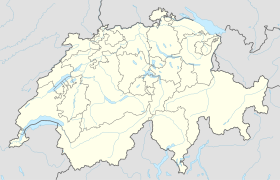Clugin
| Clugin | ||
|---|---|---|
| State : |
|
|
| Canton : |
|
|
| Region : | Viamala | |
| Political community : | Other | |
| Postal code : | 7442 | |
| former BFS no. : | 3704 | |
| Coordinates : | 752 777 / 164 764 | |
| Height : | 1013 m above sea level M. | |
| Area : | 2.49 km² | |
| Residents: | 42 (March 30, 2017) | |
| Population density : | 17 inhabitants per km² | |
|
Clugin |
||
| map | ||
|
|
||
Clugin (Romansh Clugen ) was until December 31, 2008 a political municipality in the canton of Graubünden , Switzerland. It belonged to the former Schams district in the Hinterrhein district and was oriented towards Andeer .
The village forms a clustered village and lies at the foot of the Schamserberg . Clugin was one of the smallest independent communities in Switzerland and even in the 19th century never had more than 80 inhabitants. On January 1, 2009, Clugin merged with Pignia and Andeer to form the municipality of Andeer.
history
As early as 1204, a community of free farmers with its own lower court was documented on the Schamserberg . The first mention of Clugin (in the Rhaeto-Romanic form Clugen ) dates back to 1243 . For the 13th century, the development of the country with grain cultivation and livestock farming is documented.
Landlords in Schams were first the diocese of Chur , then the barons of Vaz , later the Werdenbergs and from 1456 again the Chur people. In 1458 they bought themselves free.
In religious terms, Clugin was part of the mother church of St. Martin in Zillis . In 1530 the village was reformed and formed a parish with the communities of the lower Schamserberg (until 1894). Together with Donat , Pazen , Farden and Casti , Clugin had its own civil court.
population
| Population development | |||||||||||
|---|---|---|---|---|---|---|---|---|---|---|---|
| year | 1835 | 1850 | 1860 | 1880 | 1900 | 1950 | 1980 | 1990 | 2000 | 2005 | 2017 |
| Residents | 50 | 59 | 72 | 47 | 31 | 62 | 59 | 33 | 33 | 27 | 42 |
languages
The inhabitants Clugins spoke originally Sutselvisch , a Grison Roman dialect. In 1880 all 47 people stated Romansh as the language. By 1941 this proportion had fallen to 61%. Today Clugin is monolingual German. The only official language is German, although 15% of the population still understand Romansh.
| Languages in clugin | ||||||
| languages | 1980 census | 1990 census | 2000 census | |||
| number | proportion of | number | proportion of | number | proportion of | |
| German | 43 | 72.88% | 27 | 81.82% | 32 | 96.97% |
| Romansh | 14th | 23.73% | 5 | 15.15% | 1 | 3.03% |
| Residents | 59 | 100% | 33 | 100% | 33 | 100% |
nationality
Of the 27 residents (at the end of 2005), 26 were Swiss nationals.
Attractions
- The Clugin church with paintings by the Waltensburg master dates back to the 12th century.
- The ruins of the Cagliatscha Castle
Economy and Transport
It was not until 1951 that Clugin was connected to the cantonal road network.
literature
- Jürg Simonett: Clugin. In: Historical Lexicon of Switzerland . 2016 .
Web links
Individual evidence
- ↑ Ludmila Seifert-Uherkovich: The Church of Clugin. (Swiss Art Guide, No. 911, Series 92). Published by the Society for Swiss Art History GSK.Bern 2012, ISBN 978-3-03797-073-7 .




